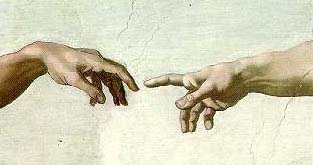 At a clergy conference once upon a time, the visiting speaker mentioned something from the Roman Catholic liturgical scholar, Robert Taft. Taft asks us to think of the Sistine Chapel, and more specifically, the image of God the Father reaching out to Adam (the celestial version of E.T.). The gap between God and humanity, as illustrated by Michaelangelo, vanishes in the liturgy. In the liturgy we come into the presence of God. It is mysterious. It is beautiful. It is real. From Morning Prayer to baptism to the Holy Eucharist, the liturgy - the words, the actions, the ritual - bring us into communion with God. I not so sure it's the words or actions themselves that bring about this communion, rather it is what happens when we join ourselves to those words and ritual actions.
At a clergy conference once upon a time, the visiting speaker mentioned something from the Roman Catholic liturgical scholar, Robert Taft. Taft asks us to think of the Sistine Chapel, and more specifically, the image of God the Father reaching out to Adam (the celestial version of E.T.). The gap between God and humanity, as illustrated by Michaelangelo, vanishes in the liturgy. In the liturgy we come into the presence of God. It is mysterious. It is beautiful. It is real. From Morning Prayer to baptism to the Holy Eucharist, the liturgy - the words, the actions, the ritual - bring us into communion with God. I not so sure it's the words or actions themselves that bring about this communion, rather it is what happens when we join ourselves to those words and ritual actions.What is so wonderful about the First Book of Common Prayer is that those words and ritual actions that for so long were kept in books only for clergy and were viewed with superstitious reverence, were made available to everyone. Everyone could see what the priest said. Everyone could read what happens at baptism and ordination. There are no secrets in the Kingdom of God. The curtain has been torn and access has been given to all. The Book of Common Prayer has given that heritage to Christianity. It helped make prayer for all Christians across all traditions - common.

No comments:
Post a Comment